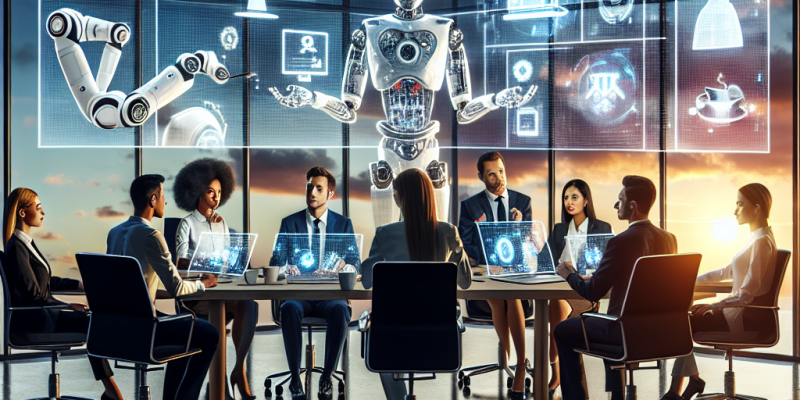The New Frontier: Exploring the Capabilities of AI in Workplace Automation

The New Frontier: Exploring the Capabilities of AI in Workplace Automation
As we enter an era increasingly dominated by technological advancements, artificial intelligence (AI) stands at the forefront, revolutionizing workplaces across industries. The integration of AI into workplace automation represents not just an evolution in efficiency but a profound rethinking of how companies structure their operations, manage their workforce, and ultimately, deliver value to their customers. This article delves into the capabilities of AI in workplace automation, its benefits, challenges, and its potential to reshape the future of work.
Understanding Workplace Automation
Workplace automation refers to the use of technology to perform tasks that would typically require human intervention. These tasks can range from simple repetitive actions to more complex decision-making processes. Automation has been a part of industrial practices for decades, but the advent of AI has introduced a new dimension, enabling machines not only to execute tasks but also to learn from data, adapt to changes, and make predictions.
The Capabilities of AI in Automation
-
Data Processing and Analysis
AI excels at handling vast amounts of data quickly and accurately. Machine learning algorithms can analyze patterns within datasets, providing insights that were previously unattainable. In sectors like finance and retail, AI tools can assess market trends, predict consumer behavior, and optimize inventory management, all of which can lead to significant cost savings and enhanced decision-making.
-
Natural Language Processing (NLP)
AI’s ability to comprehend and generate human language has transformed customer service through the use of chatbots and virtual assistants. These tools can handle a multitude of inquiries simultaneously, providing immediate responses and freeing up human employees to focus on more complex issues. NLP is also being employed in HR for resume screening and employee engagement analysis, Streamlining recruitment processes, and enhancing workplace communication.
-
Robotic Process Automation (RPA)
RPA utilizes AI to automate rule-based tasks that involve structured data. This technology is particularly useful in administrative roles, where it can streamline workflows by automating processes such as invoicing, reporting, and data entry. According to a report by Gartner, RPA can lead to cost reductions of up to 25% by significantly reducing human error and increasing processing speed.
-
Predictive Analytics
AI-driven predictive analytics tools help organizations anticipate future trends based on historical data. In manufacturing, for example, predictive maintenance powered by AI can forecast machinery failures before they occur, allowing companies to perform maintenance proactively and reduce downtime. Similarly, in retail, predictive analytics can optimize inventory levels, ensuring that products are available when customers demand them.
- Enhanced Collaboration Tools
AI technologies facilitate better collaboration within teams, especially in remote work settings. Tools powered by AI can sift through communication channels to summarize conversations, highlight action items, and even suggest meeting times based on participants’ schedules. Such efficiencies can lead to increased productivity and better project outcomes.
Benefits of AI-Based Workplace Automation
The incorporation of AI in workplace automation brings several significant benefits:
- Increased Productivity: By automating mundane and repetitive tasks, employees can focus on higher-value work that requires critical thinking and creativity.
- Cost Savings: Organizations can experience lowered operational costs as automated systems reduce the need for extensive manual labor while minimizing errors and delays.
- Enhanced Accuracy: AI systems excel at executing tasks with precision, significantly reducing human error, especially in data-centric roles.
- Scalability: AI-powered automation solutions can easily scale according to business needs, allowing companies to expand or contract their operations without the same constraints associated with human workforce management.
Challenges and Considerations
While the advantages of AI in workplace automation are compelling, organizations must navigate certain challenges:
- Job Displacement: One of the most scrutinized aspects of workplace automation is the potential for job loss. As AI systems take over specific tasks, companies must find ways to reskill employees for more advanced roles.
- Integration Complexities: Implementing AI solutions requires a robust technological infrastructure, which may necessitate significant investment in both time and resources.
- Privacy and Security Issues: The extensive data collection and analysis involved in AI applications raise concerns about data privacy and security. Organizations must ensure compliance with regulations and protect sensitive information.
- Bias and Ethical Considerations: AI systems can inadvertently perpetuate biases present in their training data, leading to unfair outcomes. Organizations must focus on developing ethical AI frameworks that promote fairness and transparency.
The Future of AI and Workplace Automation
As AI technologies continue to advance, their breadth of application within the workplace will likely expand. Emerging areas such as emotional AI, which interprets human emotions, and generative design in engineering, are on the horizon. These innovations promise even greater efficiency and creativity.
In conclusion, while the journey toward a fully automated workplace presents challenges, the potential for transformed operations, enhanced productivity, and enriched employee experiences cannot be overstated. As organizations embark on this new frontier, the key lies in harnessing AI responsibly and strategically, ensuring that progress benefits both businesses and their workforce. Embracing this dual focus will ultimately define the workplace of the future—one that is efficient, innovative, and human-centered.














